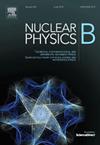Hydrostatic mass of galaxy clusters within some theories of gravity
IF 2.5
3区 物理与天体物理
Q2 PHYSICS, PARTICLES & FIELDS
引用次数: 0
Abstract
The mass of galaxy clusters (GCs) can be determined by calculating the hydrostatic equilibrium equation. In this work, we derive the hydrostatic mass of GCs within Eddington-inspired Born-Infeld (EiBI) theory, beyond Horndeski gravity (BHG), and modified emergent Newtonian gravity (MENG) with generalized uncertainty principle (GUP) correction. We apply the formulations on the masses of 10 GCs. We compare our results with the Newtonian mass of GCs. Within a regime, we get an insight that all formulations could match the Newtonian mass. Thus, the impact of the modified theories of gravity used in this work can be neglected in this regime. The noteworthy impact starts if we set m2 for EiBI theory, for BHG, and for MENG. We also compare our results from EiBI theory and BHG with the baryonic masses of the GCs. A better linear fit is achieved by EiBI theory with m2, which gives the slope of . This value is closer to unity than the one of BHG. This leads us to the fact that EiBI theory is more effective than BHG in alleviating the mass discrepancy between hydrostatic mass and baryonic mass in GCs. Nevertheless, neither EiBI theory nor BHG completely addresses the mass discrepancy problem.
求助全文
约1分钟内获得全文
求助全文
来源期刊

Nuclear Physics B
物理-物理:粒子与场物理
CiteScore
5.50
自引率
7.10%
发文量
302
审稿时长
1 months
期刊介绍:
Nuclear Physics B focuses on the domain of high energy physics, quantum field theory, statistical systems, and mathematical physics, and includes four main sections: high energy physics - phenomenology, high energy physics - theory, high energy physics - experiment, and quantum field theory, statistical systems, and mathematical physics. The emphasis is on original research papers (Frontiers Articles or Full Length Articles), but Review Articles are also welcome.
 求助内容:
求助内容: 应助结果提醒方式:
应助结果提醒方式:


